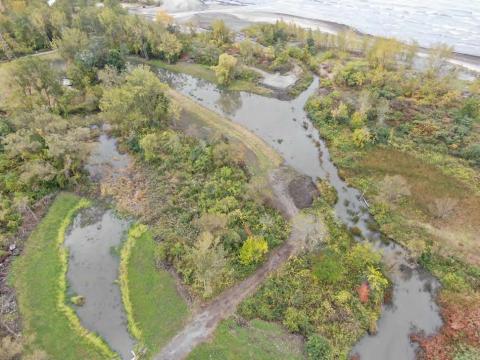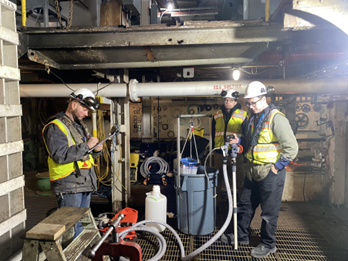Author: Great Lakes Commission
Wetland enhancement and water quality improvements at Woodlawn Beach State Park
Wetland enhancement and water quality improvements at Woodlawn Beach State Park
josterme01
Wed, 08/07/2024 – 2:12 pm
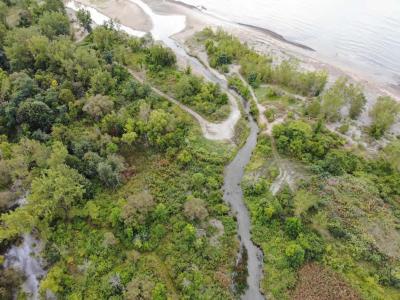
New York State Office of Parks, Recreation and Historic Preservation (OPRHP) is making strides to enhance biodiversity, wildlife habitat and improve water quality at Woodlawn Beach State Park through a grant from the Great Lakes Restoration Initiative (GLRI). OPRHP completed a project in 2023 focused on the expansion and enhancement of coastal wetland habitat along Lake Erie that is intended to benefit wildlife and improve water quality by increasing water circulation between the wetland and Blasdell Creek. The project involved expanding an existing wetland, installing a culvert [a structure which allows water to pass under a road or another barrier] to connect the wetland and adjacent Blasdell Creek, removing and controlling invasive species, and planting native wetland vegetation.
The area of Woodlawn Beach State Park is heavily urbanized and water quality in the park is often poor, particularly from elevated bacteria levels. With the project complete, water in Blasdell Creek will now flow through the expanded 4-acre oxbow-shaped wetland. The final elevations and contours in the wetland were designed to support native wetland plants and to allow physical and biological processes to remove pollutants from the water before re-entering to Blasdell Creek and into Lake Erie. The expanded wetland habitat, invasive species control, and extensive planting of native trees, shrubs and aquatic plants will also benefit wildlife such as birds, fish, reptiles, and amphibians.
Coastal wetlands are valuable resources to protect and restore due to the ecosystem services they provide. Some of which include providing habitat for critical species, protection against floods, water purification, and recreational opportunities which all occur at Woodlawn Beach State Park. The coastal wetland in the park will be positively impacted from this project by improving water quality in the park and the Lake Erie shoreline, increasing, and improving wildlife habitat, and conserving biodiversity such as the rare Wafer Ash tree that occurs in the park and prefers wetland habitats. This project will also benefit the many visitors to the park that come to walk, swim, birdwatch and enjoy a natural area on the shores of Lake Erie.
Forest Service Grants Available for Forest Restoration Projects in the Great Lakes Basin
Forest Service Grants Available for Forest Restoration Projects in the Great Lakes Basin
josterme01
Fri, 08/02/2024 – 2:04 pm
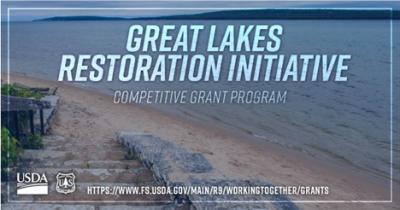
The USDA Forest Service is requesting applications for the Fiscal Year 2024 Great Lakes Restoration Initiative (GLRI) Grant Program. This program supports reforestation, ecosystem restoration and forest health improvement in the Great Lakes Basin through an agreement with the U.S. Environmental Protection Agency.
We are announcing and awarding funding through two grant opportunities:
(1) Cooperative Weed Management Areas (CWMA) Request for Applications funds partnership work to address invasive plant species that pose significant ecological threats in the Great Lakes Basin.
(2) The Forest Restoration (FR) Request for Applications funds projects that
- Mitigate Forest Insect and Disease Impacts through targeted reforestation and forest protection,
- Reduce Runoff from Degraded Sites through Green Infrastructure that includes trees, or
- Restore and Connect Coastal and Riparian Forest Habitats.
We anticipate that up to $1 million in new funds will be available for the CWMA grant, and $5.2 million for the FR grant.
Application Details
Eligible applicants can apply by 6 p.m. Eastern, September 18, 2024 on Grants.gov by searching opportunity number USDA-FS-GLRI-CWMA24 (for CWMA) or USDA-FS-GLRI-FR24 (for Forest Restoration).
Applicants can be state agencies, sovereign Tribal Nations, nonprofit organizations, educational institutions, and local governments that work within the Great Lakes Basin of Illinois, Indiana, Michigan, Minnesota, New York, Ohio, Pennsylvania, and Wisconsin.
Cooperative Weed Management Area (CWMA) funding requests must be submitted through a CWMA or similar organized partnership that manages invasive plants across jurisdictional and land ownership boundaries within a defined area.
We encourage all applicants to work with their State forestry agency to determine how their project fits into the goals and objectives of the State Forest Action Plan.
Additional notes:
- Applications must be prepared and submitted through Grants.gov by 6 p.m. Eastern on September 18, 2024.
- A webinar for prospective applicants was offered for each opportunity. Recorded webinars will be posted on the Eastern Region grants webpage.
If you have questions contact GLRI grants contact Erin Barton (erin.barton@usda.gov); (612) 476-5849 for more information.
The City of Dunkirk, New York awarded for Lake Erie Green Infrastructure Project
The City of Dunkirk, New York awarded for Lake Erie Green Infrastructure Project
josterme01
Tue, 07/23/2024 – 1:35 pm

Thanks to support from the Great Lakes Restoration Initiative (GLRI) through the Lake Erie Green Infrastructure Project, the City of Dunkirk, NY was recognized by the Great Lakes & St. Lawrence Cities Initiative as one of two cities to win the Wege Small Cities Sustainability Best Practices Award. The Wege Award highlights small cities, with populations of under 100,000 and with limited resources, who demonstrate leadership in tackling water quality issues while ensuring economic vitality and social equity. This award specifically recognizes meaningful projects that balance economic, social, and environmental aspects of protecting water quality that could be used as a best practice inspiration for other cities. In addition to being recognized as a winner of the Wege Award, the City of Dunkirk received a $3,750 award.
In 2022, the City of Dunkirk partnered with the Lake Erie Watershed Protection Alliance (LEWPA) and Chautauqua County Soil and Water Conservation District (SWCD) on the Lake Erie Green Infrastructure Project. Dunkirk’s project focuses on stormwater runoff from Hyde Creek onto the Wright Park Beaches and a stormwater outfall onto Main Street Beach. The Wright Park part of the project offers an opportunity to restore a wetland ecosystem adjacent to the open water of Lake Erie at Wright Park and address the flooding concerns at Wright Park Boulevard, while providing benefits to the bathing beaches of Wright Park. The Main Street Beach part of the project will re-route stormwater into an engineered wetland in an area of the Dunkirk Harbor where invasive knotweed and phragmites will be eradicated from the site and the new engineered wetland will be planted with native species.
The Wright Park and Main Street beaches are important amenities within the City of Dunkirk. The green infrastructure practices for this project were developed and designed with City of Dunkirk input to ensure that the look of the green infrastructure practices will be aesthetically pleasing once constructed.
The project applies green infrastructure practices to a combined 235-acre area and will help slow the flow of over 46,000,000 gallons of untreated stormwater runoff annually, which will reduce sediment and pollutant input into the Great Lakes system and reduce algal blooms in nearshore areas, as well as improve the habitat for fish, wildlife, and pollinators.
Request for Nominations to the Great Lakes Advisory Board (GLAB)
Request for Nominations to the Great Lakes Advisory Board (GLAB)
josterme01
Fri, 07/12/2024 – 12:37 pm

The U.S. Environmental Protection Agency (EPA) invites nominations from a diverse range of qualified candidates who desire to serve as members of the EPA’s Great Lakes Advisory Board (GLAB). The GLAB is chartered to provide advice and recommendations to the EPA Administrator on matters related to the Great Lakes Restoration Initiative and on implementation of the Great Lakes Water Quality Agreement between the U.S. and Canada. For appointment consideration, nominations should be submitted by July 30, 2024.
Any interested person or organization may nominate qualified persons to be considered for appointment to the GLAB. Individuals may self-nominate. For appointment consideration, interested nominees should email the application materials electronically to davicino.alana@epa.gov with the subject ‘‘GLAB Nominations 2024’’.
Nominations Details
Noninations should include:
- Current contact information for the nominee, including the nominee’s name, organization (and position within that organization), current business address, email address and daytime phone number.
- A brief statement describing the nominee’s interest in serving on the GLAB.
- A resume and a short biography (no more than two paragraphs) describing the professional and educational qualifications of the nominee, including a list of relevant activities and any current or previous service on Federal advisory committees; and
- A description of the nominee’s EPA grant funding history including current EPA grant activities if applicable. If this does not apply to the nominee, please provide a brief statement indicating so.
- Optional: Letter(s) of recommendation from a third party supporting the nomination. Letter(s) should describe how the nominee’s experience and knowledge will bring value to the work of the GLAB.
Contact Information
Alana Davicino, Designated Federal Officer, Great Lakes National Program Office, U.S. Environmental Protection Agency, 77 West Jackson Boulevard, (G–9J), Chicago, Illinois
Phone: 312–886–2307
email: davicino.alana@epa.gov
Background
Read the Federal Register Notice requesting nominations.
Sampling Ballast Water Management Systems Onboard Ships in the Great Lakes
Sampling Ballast Water Management Systems Onboard Ships in the Great Lakes
josterme01
Wed, 07/10/2024 – 10:09 am
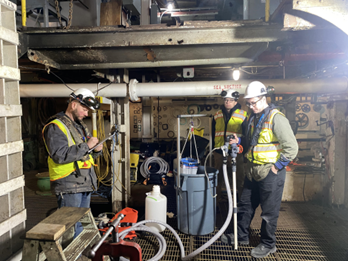
Thanks to GLRI funding, the University of Wisconsin-Superior’s Great Waters Research Collaborative (GWRC) has been working with shipping companies to collect data on board Laker vessels. Laker vessels are commercial vessels that operate exclusively on the Great Lakes. Laker vessels are not major contributors of novel invaders into the Great Lakes. They can accelerate the secondary spread of introduced aquatic nuisance species via discharge of ballast water. In many cases, environmental risk associated with the ballast water vector can be substantially reduced through installation and operation of a ballast water management system.
GWRC worked with six Great Lakes vessels to install and assess operational performance and biological efficacy of ballast water management systems. The vessels also collect ultraviolet transmittance data in the ports they visit throughout the shipping season. Ultraviolet transmittance is a measurement of water clarity, i.e., how easily UV light travels through the water, and varies from port to port. Some vessels use ultraviolet (UV) treatments as part of their ballast water management systems. For UV light to neutralize organisms, it must be able to reach them. The spatial and temporal data will inform system developers about the challenges unique to the Great Lakes.
During the 2024 season, GWRC will be adding a vessel utilizing screen filtering technology to the sampling schedule. This will allow researchers to examine the reduction in organisms provided by a filter alone. Initial data analysis has shown that operational performance of the UV systems tested relates closely to the clarity of the water taken on. Both UV and chlorination treatment systems are highly effective at treating organisms in the smaller size classes but are less effective at treating larger organisms although they typically reduce the larger organisms by several orders of magnitude.








